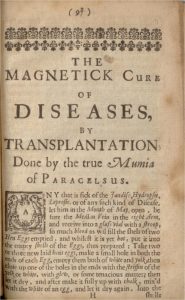October is a good time to highlight some of the more unusual items in our collection. It doesn’t get much more unusual than medicinal cannibalism, which is exactly what it sounds like: the practice of using human body parts as an ingredient in medicinal recipes. This might sound disgusting to our 21st century sensibilities, but several centuries ago it was fairly commonplace.[1] If you ever browse through the rare book collections here at the library, you can actually come across quite a few works that advocate using human-derived ingredients as weapons in the neverending battle against disease.
 One of the most interesting examples of this is Christopher Irvine’s Medicina Magnetica, published in 1656. One of the most potent implements of healing in Irvine’s medicine cabinet was the so-called magnet. This magnet was rather more morbid than the magnets we like to stick on our refrigerators. According to Irvine, “this magnet is nothing else, but dryed mans flesh, which is certain, hath a mighty attractive power; but it must be taken, if it be possible, from the body of a man that dies a violent death, and yet while it is warm.”[2] This is undoubtedly gruesome, but the squeamish reader need not fret, because Irvine also supplies this recipe, which is “not gotten with so much cruelty”: “take therefore the blood of a sound young man…this blood suffered to congeal, pour off the water swimming aloft, and keep it while it is cold, dry it in the shade, and then moisten it with the water poured off, and dry it again; repeating this so oft, till the earth hath drunk up all its water; then dry it, and keep it for thy use.”[3] This prepared blood is then mixed with mans dung, wine, and sweat to create a magnet that encompasses the entirety of man’s body, which should be kept in a tightly shut vessel.
One of the most interesting examples of this is Christopher Irvine’s Medicina Magnetica, published in 1656. One of the most potent implements of healing in Irvine’s medicine cabinet was the so-called magnet. This magnet was rather more morbid than the magnets we like to stick on our refrigerators. According to Irvine, “this magnet is nothing else, but dryed mans flesh, which is certain, hath a mighty attractive power; but it must be taken, if it be possible, from the body of a man that dies a violent death, and yet while it is warm.”[2] This is undoubtedly gruesome, but the squeamish reader need not fret, because Irvine also supplies this recipe, which is “not gotten with so much cruelty”: “take therefore the blood of a sound young man…this blood suffered to congeal, pour off the water swimming aloft, and keep it while it is cold, dry it in the shade, and then moisten it with the water poured off, and dry it again; repeating this so oft, till the earth hath drunk up all its water; then dry it, and keep it for thy use.”[3] This prepared blood is then mixed with mans dung, wine, and sweat to create a magnet that encompasses the entirety of man’s body, which should be kept in a tightly shut vessel.
And how should one use this wondrous substance? According to Irvine, the magnet could then be used in a process called transplantation. This procedure was based on the early modern belief that the body was controlled and regulated by unseen forces called vital spirits.[4] Placing the prepared magnet on the afflicted body part could impregnate it with the vital spirits causing the  disease, and this spiritually infused magnet could then be fed to an animal, or mixed with earth that was then planted with herbs. The diseased vital spirits were thereby removed from the human and sent into the animal or plants, and the ailing person could recover.[5]
disease, and this spiritually infused magnet could then be fed to an animal, or mixed with earth that was then planted with herbs. The diseased vital spirits were thereby removed from the human and sent into the animal or plants, and the ailing person could recover.[5]
The belief in vital spirits is also the reason that human flesh and blood used for medicinal purposes needed to be harvested while it was fresh and warm – and why the body of an executed criminal was a particularly viable source. Vital spirits taken from a young and healthy body were much more potent than those taken from a body that was ravaged by disease and old age, making someone who was cut down in the prime of life a particularly potent source. Just something to keep in mind as we head into Halloween.
[1] A great survey of the history of corpse medicine is Richard Sugg’s Mummies, Cannibals and Vampires: The History of Corpse Medicine from the Renaissance to the Victorians. (London and New York): Routledge, 2011. Page 80.
[2] Irvine, 79.
[3] Irvine, 79.
[4] For an in-depth exploration of this topic, see Chapter 6 in Sugg, “Eating the Soul.”
[5] Irvine, 70-72.
